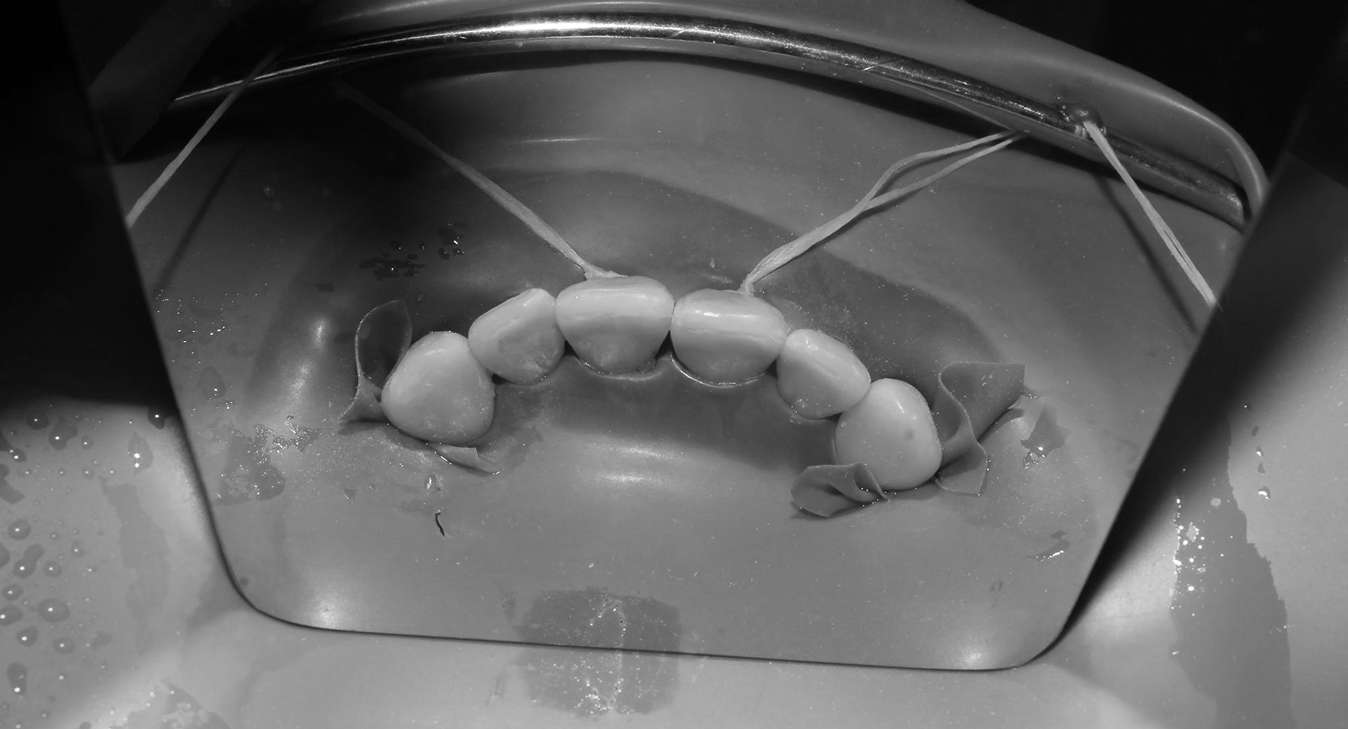What is a Composite Fixed Bridge?
A composite fixed bridge is a dental restoration used to replace one or more missing teeth. It consists of an artificial tooth made from durable composite resin, bonded securely to the natural teeth on either side of the gap. This cost-effective and minimally invasive solution restores the appearance and function of your smile, often completed in a single visit.
Composite Fixed Bridges in Argentina.
Composite fixed bridges are becoming a popular option for dental care abroad. On this page, you’ll find clear information about the procedure and how to make a well-informed decision about treatment in Argentina.
- Steps in its Procedure
- Why a Composite Bridge
- Tips for a Composite Bridge


Why Choosing a Composite Fixed Bridge: Advantages.
This type of bridge can be a good fit if you’re looking to restore missing teeth with a natural look. It’s often chosen for being minimally invasive and budget-friendly. The dentist will assess your oral health to see if it’s suitable, taking into account the condition of your gums and nearby teeth. An intake consultation is the best way to explore if this treatment matches your needs.
Why Getting a Zirconia Fixed Bridge in Argentina?
Choosing to get a Composite bridge done in Argentina has several advantages.
Cost-Effective Quality
If you’re looking for a way to replace missing teeth without spending a fortune, a composite fixed bridge could be a good fit. It’s a more affordable option than zirconia, but still gives you solid function and a natural look. In Argentina, dental treatments tend to be much more cost-friendly — sometimes up to 70% less than what you’d pay in the U.S. That means you can get high-quality care without the heavy price tag.
Aesthetic Versatility
One of the nice things about composite bridges is how well they can match the rest of your smile. The material can be shaped and polished right in the dental chair to blend with your other teeth. Especially if the bridge is going in a visible spot, that attention to detail makes a big difference. Dentists here in Argentina usually take the time to get it just right — so your new bridge looks like it’s always been part of your smile.
Quick and Efficient Treatment
If you’re short on time, composite bridges can often be done quicker than other options. In some cases, everything from shaping to bonding can be finished in a single visit. Many clinics in Argentina use modern techniques to make things efficient, so you spend less time in the chair and more time enjoying your trip.
Repairability and Adjustability
One thing patients often appreciate is that composite bridges can be repaired if needed. So, if there’s a small chip or some wear after a while, you usually don’t need to replace the whole thing. Many dentists in Argentina are experienced with these touch-ups, making it easier to keep your bridge in good shape for years to come.
Comfort-First Approach
Composite bridges are lightweight and bond well to your existing teeth — and the best part is, they often don’t require much reshaping. That means the process feels a bit gentler and more comfortable overall. Here in Argentina, many dentists aim to keep as much of your natural tooth as possible, helping your bridge feel like a natural fit from day one.
The Procedure of Composite Fixed Bridges Explained in a Video.
Before deciding to proceed with a treatment like a composite fixed bridge, we understand you’d want to know the steps involved in the procedure. We created a short video to get you an idea of this process and show you how your dental team will care for you every step of the way.
Steps Before, During and After:
A Composite Bridge Treatment.
The procedure for a composite fixed bridge differs from a regular crown or filling, so we’ll explain what to expect before, during, and after treatment. The dentists in our network will also provide a detailed plan tailored to your case in advance.
Examination and Planning
It all starts with a consultation. Your dentist will check the health of your teeth and gums to see if they can support a composite fixed bridge. Digital scans or X-rays may be taken to get a clearer picture of the area. This is also your chance to talk about what you’re hoping for, so the plan can be tailored to your needs.
Keeping your mouth clean and sharing any health details, like medications you’re taking, helps make sure everything goes smoothly from the start.
The Actual Treatment
The treatment itself is usually straightforward and designed to keep you comfortable. The teeth next to the gap may need a little reshaping to support the bridge. Then, the dentist carefully builds the bridge using composite material, shaping and bonding it so it fits well and looks natural.
If needed, a local anesthetic will be used. You’ll be able to check the look before everything is set, so the result feels just right for you.
Taking Care Aftwards
Once your bridge is in place, your dentist will guide you on how to care for it — brushing, flossing, and using the right tools to keep everything clean. It’s best to go easy on very hard foods for a few days while the bridge settles.
Follow-up visits help make sure everything’s working as it should. If anything feels off, reaching out early helps keep your smile comfortable and secure.
Your Results
The final result is a natural-looking, functional smile that restores your confidence and oral health. Composite fixed bridges blend seamlessly with your existing teeth, providing a durable solution for missing teeth. You’ll notice an immediate improvement in your ability to chew and speak comfortably.
By following the care instructions and attending routine dental check-ups, your composite fixed bridge can last for many years. The lightweight and biocompatible nature of the material make it feels comfortable in your mouth, making it a practical and aesthetically pleasing choice for restoring your smile.

Traveling in Argentina While Getting Your Composite Bridge.
Getting a composite fixed bridge can be a step toward restoring your smile — and if you’re in Argentina, it’s also a chance to experience the culture of Buenos Aires. This guide helps you understand the treatment while offering ideas for making the most of your time in the city.
Argentina vs. US:
The Cost of Composite Bridges.
Composite bridges in Argentina are often more affordable than in the U.S., Canada, or Europe. This section gives you a general idea of pricing, so you can see how costs compare while still focusing on quality care.
| Composite Fixed Bridge Procedure Cost | US & Canada | Argentina |
|---|---|---|
| Initial Consultation | $100-$200 | $50-$100 |
| Diagnostic Imaging (X-rays) | $150-$300 | $75-$150 |
| Tooth Preparation and Impressions | $500-$1,000 | $250-$500 |
| Composite Bridge Fabrication | $1,000-$3,000 | $400-$1,200 |
| Bridge Placement and Bonding | $1,500-$3,500 | $600-$1,500 |
| Post-Treatment Care | $100-$300 | $50-$150 |
| Total Costs of Composite 3-unit Bridge Procedure | $3,350-$8,300 | $1,425-$3,500 |

Why Choosing Teeth Traveler for Your Composite Bridge?
We would love to get you explained why people choose their clinics via Teeth Traveler, also for their composite bridges. Its because of our selection procedure regarding our dental network and our philosophy on dentistry.
The Best Dentist Chosen in Argentina
for Your Composite Bridge.
When you are about to choose a dentist for this type of treatment, it is wise to do this properly and with the right information at hand. We therefore made a solid guide to get you through this selection process with the right tips.
Your Guide to Choose a Dental Clinic Abroad
The Quality Of The Composite Being Used for Your Bridge.
Why it’s important: Not all composite resins are the same. High-quality materials resist staining better and are more likely to stay strong and natural-looking over time. Lower-grade materials may chip, discolor, or wear down faster.
What to look for: Find out what type of composite resin the clinic uses and whether they source it from trusted manufacturers. Good technique also matters — a well-applied bridge will hold up better and look more natural.
Essential to remember: Quality materials make a big difference in both how your bridge looks and how long it lasts. Choosing a clinic that prioritizes this gives you peace of mind about your treatment’s durability and appearance.
Your Dentist Should Be Expert in Composite Fixed Bridges.
Why it’s important: A dentist experienced in composite fixed bridges knows how to shape and bond the material so it fits well and looks natural. Their skill helps avoid common issues like uneven bonding, early wear, or staining — making the bridge both functional and visually seamless.
What to look for: Look for a dentist who regularly works with composite bridges and uses high-quality bonding techniques. Reviews, patient stories, and before-and-after photos can help give you a sense of their results and approach.
Essential to remember: Composite bridges need a steady hand and attention to detail. A skilled dentist can make sure your bridge blends comfortably with your smile and is built to last.
- Review Patiënt Reviews
- A Dentist's Certifications
- Schedule an Intake for Free
- Be Aware of Very Cheap Prices
Essentials: Getting A Composite Bridge.
Finding the right dentist for your composite fixed bridge is important, but other factors also matter when planning treatment abroad. Below is a clear overview to help you prepare and make an informed decision.
Composite Material Used
Composite isn’t just one material — there are different grades, and they don’t all perform the same way. Premium composites are designed to mimic the natural color and texture of real teeth, and they tend to hold up better over time. That means fewer stains, less wear, and a more lifelike appearance that lasts.
Precision Preparing Tooth
Before placing a composite fixed bridge, the supporting teeth need to be shaped with care. This step is all about making sure the bridge fits comfortably and bonds securely. When done properly, it protects your natural teeth and helps the bridge feel like a natural part of your bite — not something added on.
Expertise in Bonding
A big part of the bridge’s success comes down to how well it’s bonded in place. Advanced bonding systems help create a tight, lasting seal — keeping food and bacteria out and your smile secure. A well-bonded bridge not only stays put, but is also easier to keep clean and maintain.
Custom Color Matching
Getting the color and texture right can make all the difference. When the dentist takes time to match the shade of the bridge to your natural teeth, the result is much more seamless. A good color match means your bridge won’t stand out — it’ll simply blend in with your smile.
Long-Term Guidance
Composite bridges don’t require special routines, but a bit of extra care helps. Your clinic should explain how to clean around the bridge — things like using special floss or interdental brushes can go a long way. With the right daily habits, your bridge will stay comfortable, clean, and looking its best.
Adjustability Options
One of the nice things about composite is that if something small chips or wears down, it can usually be fixed without starting from scratch. Many dentists who work with composites can repair and refresh the bridge, helping you get more out of it over time — without the need for full replacement.
How Our Associated Dentists
Take Care After Your Treatment.
Your comfort matters — during treatment and once you’re back home. The clinics we work with aim to provide a thoughtful experience and clear follow-up for lasting confidence in your care.
Aftercare Services
At Home
Prices Packages for Composite Fixed Bridges.
Here you’ll find indicative prices for composite fixed bridges from clinics in our network. Final costs depend on your specific needs and will be shared by the clinic after a consultation — with no obligation to continue.
Composite Regular
Treatment duration between 1-3 daysSame Day Treatment
*From Price
-
Scan & Pro-Cleaning
-
Composite Bridge*
-
Online Aftercare
-
Follow-up Dentistry at Home
-
Material Guarantee
*Composite 3-unit Bridge Structure
A Direct Agreement with The Dentist
Composite Smile
Treatment duration between 1-3 daysSame Day Treatment
*From Price
-
Composite Regular
-
Bonding for Imperfection*
-
Professional Whitening
-
Follow-up Dentistry at Home
-
Material Guarantee
*Composite Bonding for One Tooth
A Direct Agreement with The Dentist
Composite Makeover
Treatment duration between 2-3 daysSame Day Treatment
*From Price
-
Composite Regular
-
Smile Makeover Light*
-
Personal Care Plan
-
Follow-up Dentistry at Home
-
Material Guarantee
*Includes All Bondings and a Whitening
A Direct Agreement with The Dentist
Reviews of
Composite Fixed Bridges.
Read within this section how our associated dentists successfully performed several treatments for composite bridges and what their patients shared with us.





Plan an Intake. Online. For Free.
If you’re considering a composite bridge, you can schedule a free online intake with one of the dentists we work with. It’s a chance to ask questions, discuss your needs, and, if you’d like, receive a no-obligation quote — entirely at your own pace.
Frequently Asked Questions (FAQs) on Composite Fixed Bridges.
In this section we highlight all the frequently asked questions on composite bridges and answered them briefly.
How long do composite bridges last?
Composite bridges typically last 5–10 years with proper care. Their longevity depends on maintaining good oral hygiene, avoiding hard foods, and regular dental check-ups. To maximize the lifespan of your bridge, follow your dentist’s cleaning instructions and schedule periodic evaluations to check its condition.
What is the best type of fixed bridge?
The best type of fixed bridge depends on your needs. Composite bridges are cost-effective and aesthetic but less durable than zirconia. Porcelain offers a natural look, while zirconia is highly durable. Consult your dentist to determine the most suitable option based on your dental health and preferences.
How much is a composite bridge?
A composite bridge costs between $300 and $1,500 per unit, depending on the complexity and location. Pricing varies based on the number of teeth being replaced and the dentist’s expertise. Schedule a consultation to receive an accurate estimate tailored to your case.
How many teeth can a fixed bridge replace?
A fixed bridge can replace one to four missing teeth in a row, depending on the health of your supporting teeth or implants. Consult your dentist to assess whether a bridge is suitable for the number of teeth you need replaced.
Does a bridge cost more than an implant?
A bridge is generally less expensive than a dental implant. However, implants offer greater longevity and help preserve bone structure. Bridges are ideal for short-term affordability, while implants may be better for long-term benefits. Discuss costs and benefits with your dentist to make an informed decision.
Can I get a bridge with missing teeth?
Yes, a bridge is specifically designed to replace missing teeth. The bridge relies on adjacent teeth or implants for support, creating a natural appearance and restoring function. Your dentist can evaluate if your remaining teeth or jaw structure can adequately support the bridge.
What is a cheaper alternative to a dental bridge?
Partial dentures are a more affordable alternative to a dental bridge. They are removable and cost less upfront, though they may not provide the same stability or aesthetics. Schedule a consultation to explore cost-effective options tailored to your dental needs.
What is the least expensive dental bridge?
The least expensive dental bridge is a resin-bonded bridge, costing around $250–$1,000 per tooth. It’s ideal for front teeth but less durable for molars. Consult your dentist to see if this cost-effective option fits your specific dental requirements.
Ask Your Question
At Teeth Traveler, we’re here to share helpful information — not to offer medical advice. This information on this page is for general informational purposes only and does not constitute medical advice, diagnosis, or treatment. Teeth Traveler is not a healthcare provider and does not offer medical services. The clinics listed on our platform operate independently and are responsible for the care they provide. While we aim to offer helpful guidance, readers are encouraged to consult directly with licensed dental professionals before making healthcare decisions or pursuing treatment abroad. No rights may be derived from the information provided on this page. For more details, check our disclaimer and terms of use.
